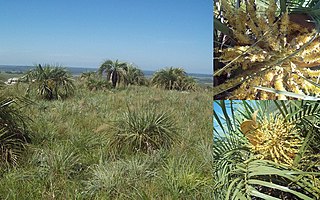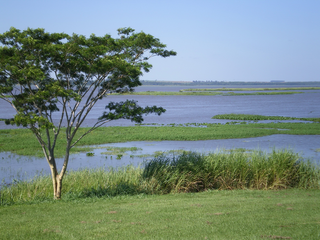This article needs additional citations for verification .(January 2024) |

Because of its biodiversity, Paraguay is an appealing destination for ecotourism. Tourists particularly come to experience the natural landscape and birdwatching. [1]
This article needs additional citations for verification .(January 2024) |

Because of its biodiversity, Paraguay is an appealing destination for ecotourism. Tourists particularly come to experience the natural landscape and birdwatching. [1]

13000 species of plants have been recorded in Paraguay, including many threatened species.[ citation needed ] Deforestation represents a significant threat to the biodiversity of Paraguay. The lapacho rosado is the national tree of Paraguay. [2] [3] 13000 species of animals have been recorded in Paraguay, including many threatened species.[ citation needed ] It is an increasingly popular destination for birdwatching. [4]



Tatí Yupí Refuge, Reserva Itabó, Refugio Carapá and Refugio Mbaracayú reserves are driven by the Itaipu Dam.

Alto Paraná is a department in Paraguay. The capital is Ciudad del Este.

Amambay is a department in Paraguay. The capital is Pedro Juan Caballero.
National System of Conservation Areas is part of the Ministry of Environment and Energy (MINAE) of Costa Rica. It is the administrator for the nation's national parks, conservation areas, and other protected natural areas.

Hernandarias is a district and city of the Alto Paraná Department, Paraguay. It was named after Hernando Arias de Saavedra, the first South American governor born in the Americas. It is located across the highway from the Itaipu Dam.

The Iguazú National Park is a national park of Argentina, located in the Iguazú Department, in the north of the province of Misiones, Argentine Mesopotamia. It has an area of 677 km2 (261 sq mi).

Protected areas of Brazil included various classes of area according to the National System of Nature Conservation Units (SNUC), a formal, unified system for federal, state and municipal parks created in 2000.
Maquenque Wildlife Refuge, is a protected area in Costa Rica, managed under the Arenal Huetar Norte Conservation Area, it was created in 2005 by decree 32405-MINAE.

The protected areas of Nicaragua are areas that have natural beauty or significance and are protected by Nicaragua. Nicaragua has 78 protected areas that cover 22,422 km2, about 17.3% of the nations landmass. The National System of Protected Areas (SINAP) is administered by the Ministry of the Environment and Natural Resources (MARENA).

The Central American pine–oak forests is a tropical and subtropical coniferous forests ecoregion in the mountains of northern Central America and Chiapas state in southern Mexico.
Refugio Carapá is a biological reserve in the Department of Canindeyú, Paraguay, on the right bank of the Paraná River. It is one of eight sites earmarked as an ecological reserve near the Itaipu Dam, one of the largest dams in the world, located between Paraguay and Brazil. The reserve is 260 km (160 mi) north of the Ciudad del Este. It was founded in 1984 and is 3,250 hectares.
Tatí Yupí is a biological reserve in the district of Hernandarias, Alto Paraná Department, Paraguay. It is located on the right bank of the Paraná river and covers area of 2,245 hectares. The reserve is one of 8 sites earmarked as the ecological reserve by the Itaipu, the largest dam in production in the world, located between Paraguay and Brazil.
The San Rafael Reserve of Manageable Resources is one of the most important reserves of natural resources in Paraguay.

Butia paraguayensis is a species of Butia palm tree found in the cerrado region of South America. Its natural range runs from Mato Grosso do Sul and São Paulo in southern Brazil through Paraguay to northern Argentina and Uruguay. It was given the name dwarf yatay palm in English by 2000, and it is locally known as yata'i in Guaraní in Paraguay, or butiá-do-cerrado in Portuguese in Rio Grande do Sul, Brazil.
Under UNESCO’s Man and the Biosphere Programme, there are 125 biosphere reserves recognized as part of the World Network of Biosphere Reserves in Latin America and the Caribbean. These are distributed across 21 countries in the region.

The Hispaniolan moist forests are a tropical moist broadleaf forest ecoregion on the island of Hispaniola. They cover 46,000 km2 (18,000 sq mi), around 60% of the island's area.
Protected areas of Panama include:

The Mbaracayú Forest Nature Reserve is a protected area in Paraguay.

Butia campicola is a very small species of Butia palm with an underground trunk; native to the cerrados of central Paraguay and south-central Brazil.